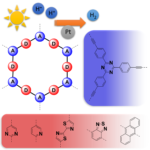Schwarz, D.; Amitava, A.; Ichangi, A.; Lyu, P.; Opanasenko, M. V.; Goßler, F. R.; König, T. A. F.; Čejka, J.; Nachtigall, P.; Thomas, A.; Bojdys,* M. J. Chem. Eur. J. 2018, 24. DOI: 10.1002/chem.201802902 [OPEN ACCESS]
 Light-driven water splitting is a potential source of abundant, clean energy, yet efficient charge-separation and size and position of the bandgap in heterogeneous photocatalysts are challenging to predict and design. Synthetic attempts to tune the bandgap of polymer photocatalysts classically rely on variations of the sizes of their π-conjugated domains. However, only donor-acceptor dyads hold the key to prevent undesired electron-hole recombination within the catalyst via efficient charge separation. Building on our previous success in incorporating electron-donating, sulphur-containing linkers and electron-withdrawing, triazine (C3N3) units into porous polymers, we report the synthesis of six visible-light active, triazine-based polymers with a high heteroatom-content of S and N that photocatalytically generate H2 from water: up to 915 µmol h-1 g-1 with Pt co-catalyst, and – as one of the highest to-date reported values – 200 µmol h-1 g-1 without. The highly modular Sonogashira-Hagihara cross-coupling reaction we employ, enables a systematic study of mixed (S, N, C) and (N, C)-only polymer systems. Our results highlight that photocatalytic water-splitting does not only require an ideal optical bandgap of ~2.2 eV, but that the choice of donor-acceptor motifs profoundly impacts charge-transfer and catalytic activity.
Light-driven water splitting is a potential source of abundant, clean energy, yet efficient charge-separation and size and position of the bandgap in heterogeneous photocatalysts are challenging to predict and design. Synthetic attempts to tune the bandgap of polymer photocatalysts classically rely on variations of the sizes of their π-conjugated domains. However, only donor-acceptor dyads hold the key to prevent undesired electron-hole recombination within the catalyst via efficient charge separation. Building on our previous success in incorporating electron-donating, sulphur-containing linkers and electron-withdrawing, triazine (C3N3) units into porous polymers, we report the synthesis of six visible-light active, triazine-based polymers with a high heteroatom-content of S and N that photocatalytically generate H2 from water: up to 915 µmol h-1 g-1 with Pt co-catalyst, and – as one of the highest to-date reported values – 200 µmol h-1 g-1 without. The highly modular Sonogashira-Hagihara cross-coupling reaction we employ, enables a systematic study of mixed (S, N, C) and (N, C)-only polymer systems. Our results highlight that photocatalytic water-splitting does not only require an ideal optical bandgap of ~2.2 eV, but that the choice of donor-acceptor motifs profoundly impacts charge-transfer and catalytic activity.
